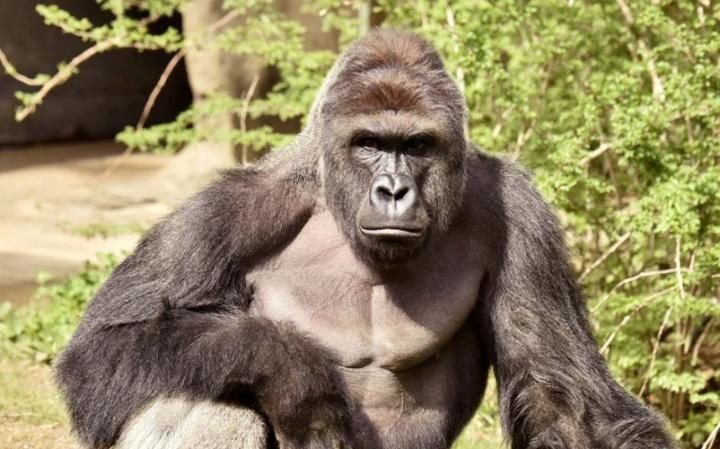Harambe: The Meme, the Myth, the Legend
October 27, 2016
Who is Harambe?
I felt a great disturbance in the Force, as if millions of voices suddenly cried out in terror, and were suddenly silenced. I fear something terrible has happened.”
-Obi Wan Kenobi
Harambe. The now iconic western lowland gorilla was shot and killed earlier this year. The incident occurred at 4:00 pm EDT on May 28, 2016 when a three year old boy climbed the three foot tall fence enclosing the gorilla pen and fell into the moat. Zoo officials immediately signaled for the gorillas to exit the enclosure. The two females in the enclosure quickly exited the Gorilla World Exhibit however, Harambe, a male western lowland gorilla, ignored zoo staff and went to examine the boy. Footage taken by witnesses to the event show Harambe picking up the child and violently dragging it through the water. Zoo officials claim that Harambe displayed aggressive behaviors, referred to as “strutting”, through his stance and the manner in which he walked. Such behaviors are performed by male gorillas in territorial stand offs and by females in defense of their young and usually precede violence. The zoo ultimately decided to kill Harambe so as to ensure the safety of the child.
Harambe was born in the Gladys Porter Zoo in Brownsville, Texas. He was transferred from Gladys Porter to the Cincinnati Zoo in 2014 to integrate him into an adult gorilla group and develop his social skills. He was tragically killed the day after his seventeenth birthday. Yet today he is known to most internet meme aficionados as the most successful meme of 2016. How did this come to be?
The Dankest Harambe Memes
The Harambe meme consists traditionally of a picture of Harambe, or any gorilla, accompanied by humorous, ironic, or sardonic text. The original round of memes mocked the mother of the child and the zoo officials who shot Harambe. But as the meme gained traction Harambe became a vessel for animal rights activists, political ideas, and standard meme humor.
The underlying characteristic found in most standard Harambe memes is an excessive and absurd mourning or tribute to Harambe’s life. The Washington post wrote an article concerning the nature of Harambe memes; “The idea is, the more intense and more sincere-seeming the expression of mourning is, the funnier the joke”. In fact it is exactly this unrestrained expression of sarcastic sorrow that forced the Cincinnati Zoo to delete their twitter account.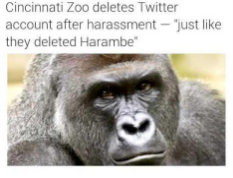
Following the killing of Harambe any post made by the zoo was inundated by these burlesque mourners. The zoo, which
regularly posted about their animals, could not handle the intense amount of spam and ridicule they were receiving and were forced to delete their twitter account.
 Harambe meme come in a few distinct categories other than the exacerbated mourning of internet trolls. The first of which is memes which deal with the killing of Harambe having been a conspiracy. These memes jokingly involve people of high political standings and imply them as having been behind the killing.
Harambe meme come in a few distinct categories other than the exacerbated mourning of internet trolls. The first of which is memes which deal with the killing of Harambe having been a conspiracy. These memes jokingly involve people of high political standings and imply them as having been behind the killing.
The next subset of Harambe’s satirically question the morality of the Harambe shooting, whether or not the zoo could have used non-lethal means to save the child, and who, if anyone, was to blame for this tragedy.
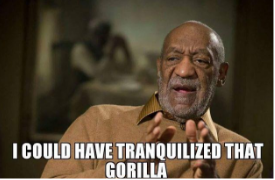
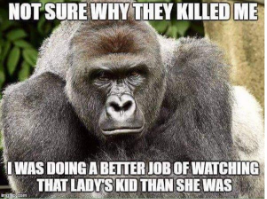

The third type of Harambe memes deals with the slogan which developed as a nonsensical and humorous tribute to the memory of Harambe, “[male genitalia] out for Harambe”. The slogan, now universally recognized as Harambe’s official slogan by meme connoisseurs. The identity of its original inventor is controversial but it is generally agreed upon that comedian Brandon Wardell began the initial spread of the phrase when he tweeted “[male genitalia] out for Harambe” on July 4th. Later that day Wardwell posted a vine in which a group of people are seen chanting the slogan. On July 6th Brandon released another vine of Danny Trejo and himself saying the phrase. If this phrase is yelled in a large group of memesters it will provoke the others to reciprocate the slogan. It is rather well known amongst the young adults and a common subject of memes.
On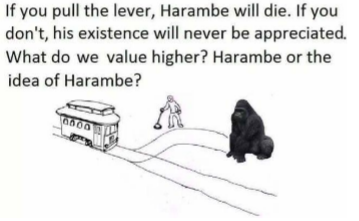 e particular Harambe meme sparked great interest and debate. Said meme displays a variation of the trolley car morality question; in this instance however, Harambe is tied to one of the tracks and the other set of tracks is empty. You are tasked with deciding whether or not you kill Harambe. The reader is told that if he pulls the lever Harambe dies, but if he doesn’t kill Harambe then no one will appreciate his existence. The reader needs to determine what he most values, Harambe, or the idea of Harambe.
e particular Harambe meme sparked great interest and debate. Said meme displays a variation of the trolley car morality question; in this instance however, Harambe is tied to one of the tracks and the other set of tracks is empty. You are tasked with deciding whether or not you kill Harambe. The reader is told that if he pulls the lever Harambe dies, but if he doesn’t kill Harambe then no one will appreciate his existence. The reader needs to determine what he most values, Harambe, or the idea of Harambe.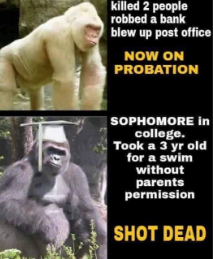
However, Harambe is not all sardonic and politically incorrect humor, he has been used to make serious and worthwhile social commentary through the use of satire. During the resurgence of police brutality in the news meme makers released a Harambe meme comparing an albino gorilla to Harambe and then contrasting the treatment they received for their crimes.
The Rise and Fall of Harambe
Harambe had his initial burst of population the day after his death when footage of him with the child went viral and the media reported on the tragic shooting of an endangered primate. However, Harambe was not yet a recognized meme at the time. A few Harambe memes appeared but at the time they had no traction and no following. Internet trolls over–mourning the death of Harambe on social media were overshadowed by animal rights activists and common people with a sincere interest in the zoo’s controversial decision.
How can the progression of the popularity of an internet meme be accurately documented? Browsers track the amount of times people search for a particular term. In this case our term is “Harambe” and we can use google trends to study the growth of Harambe.

Harambe appears to have been a popular meme almost immediately, however, this is not the case. The enormous initial spike in searches for Harambe is in the week immediately following his death, from May 29 to June 4th, and is instead attributed to the massive news coverage surrounding his death and to the millions of people watching the viral video of Harambe dragging the child through the water. The initial spike is a rapid increase in searches for Harambe that lasts a little less than a week before it begins to taper off; a standard characteristic for a news story. After that short week searches for Harambe plummet to almost nothing. However, as time goes on the graph shows interest in Harambe slowly rise. This rise is the Harambe meme gradually saturating itself into internet meme culture. Harambe at this point had gained traction in the meme world and was being used by countless people who created new, or spread existing Harambe memes. Harambe’s most successful month was actually mid to late August where searches for Harambe peaked, surpassing the amount of searches during the week of news interest in him. This is truly a testament to the power and popularity of memes in the modern day. Unfortunately, Harambe has been steadily declining in popularity as of mid to late august and will soon be replaced by newer and danker memes. God bless Harambe, may his memory be a blessing.

